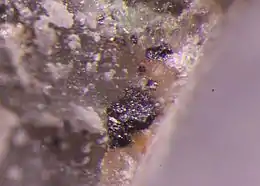| Uytenbogaardtite | |
|---|---|
 Uytenbogaardtite, from New Bullfrog Mine, Nye County, Nevada, United States of America | |
| General | |
| Category | Sulfide mineral |
| Formula (repeating unit) | Ag3AuS2 |
| IMA symbol | Uyt<oref>Warr, L.N. (2021). "IMA–CNMNC approved mineral symbols". Mineralogical Magazine. 85 (3): 291–320. Bibcode:2021MinM...85..291W. doi:10.1180/mgm.2021.43. S2CID 235729616.</ref> |
| Strunz classification | 2.BA.40b |
| Crystal system | Trigonal |
| Crystal class | Ditrigonal pyramidal (3m) H-M symbol: (3m) |
| Space group | R3c |
| Identification | |
| Formula mass | 584.70 g/mol |
| Color | Greyish white |
| Crystal habit | Microscopic crystals |
| Fracture | Irregular |
| Tenacity | Malleable |
| Mohs scale hardness | 2 |
| Luster | Metallic |
| Diaphaneity | Opaque |
| Specific gravity | 8.405 |
| Pleochroism | Weak |
| References | [1][2][3][4][5] |
The mineral uytenbogaardtite, Ag3AuS2, is a soft, greyish white sulfide mineral, occurring in hydrothermal Au-Ag-quartz veins. It occurs as tiny crystals, visible only with a microscope. It has a metallic luster and a hardness on the Mohs scale of 2 (gypsum).
It forms, together with petzite (Ag3AuTe2) and fischesserite (Ag3AuSe2) the uytenbogaardtite group. The type locality is Tambang Sawah, Bengkulu district, Sumatra island, Indonesia.
Common impurities in the uytenbogaardtite are copper, selenium, and tellurium.
It is named after the Dutch mineralogist Willem Uytenbogaardt (1918–2012), Professor of Geology, Technical University, Delft, The Netherlands, prominent ore microscopist.
See also
References
This article is issued from Wikipedia. The text is licensed under Creative Commons - Attribution - Sharealike. Additional terms may apply for the media files.